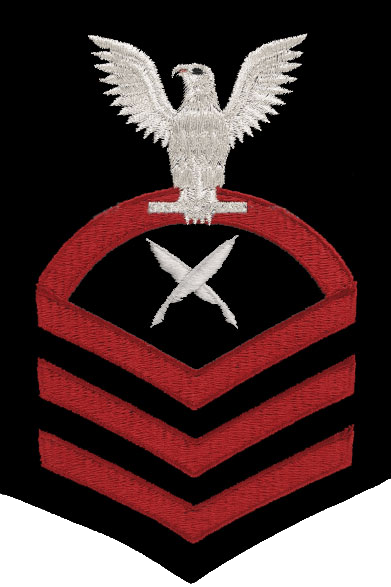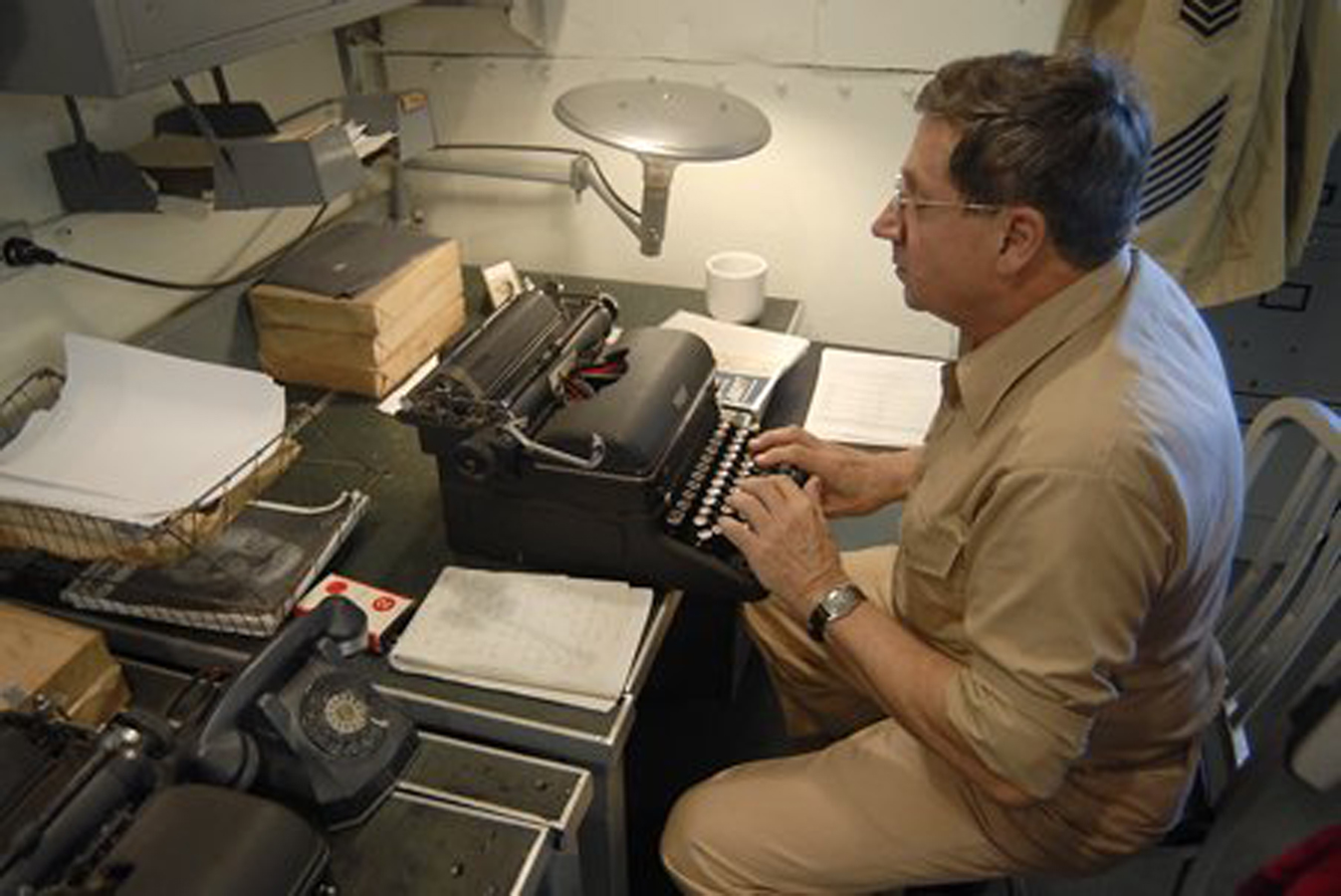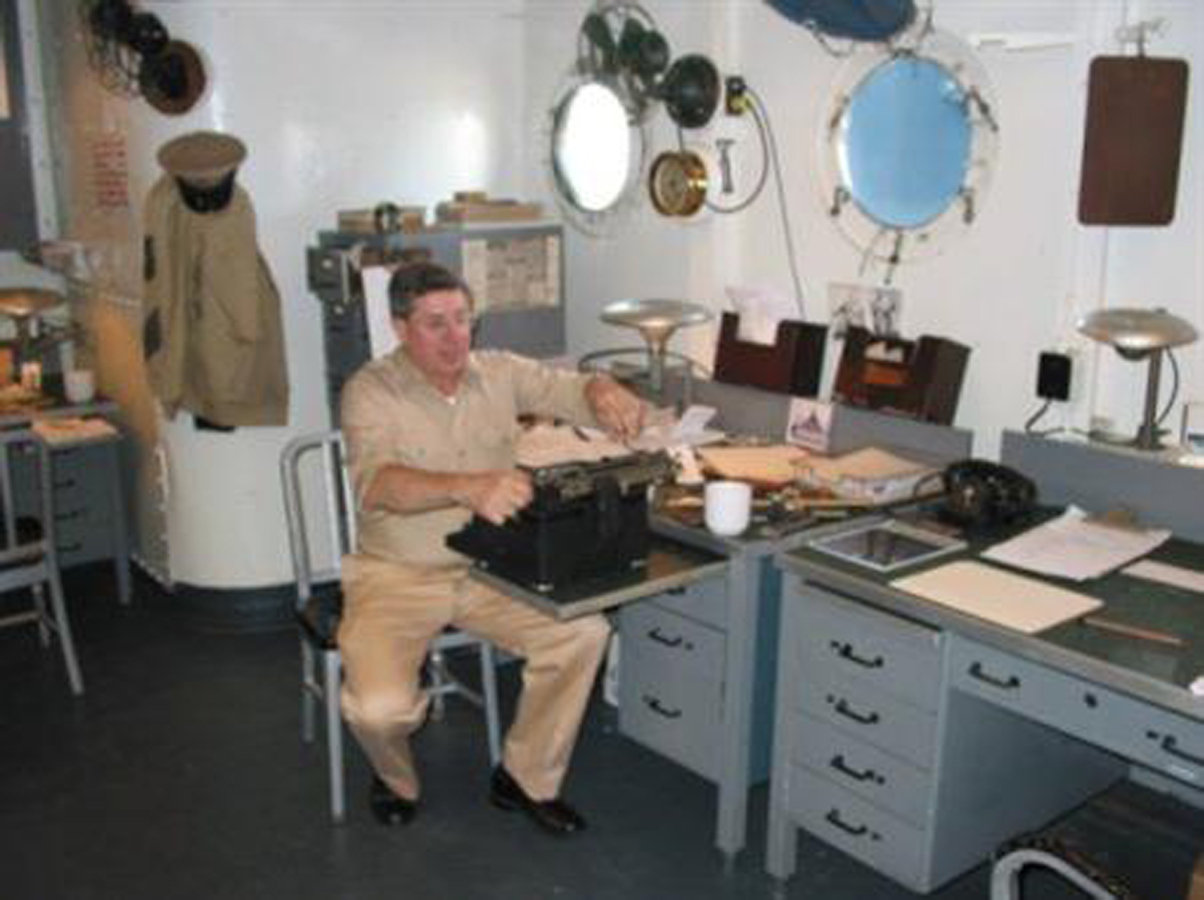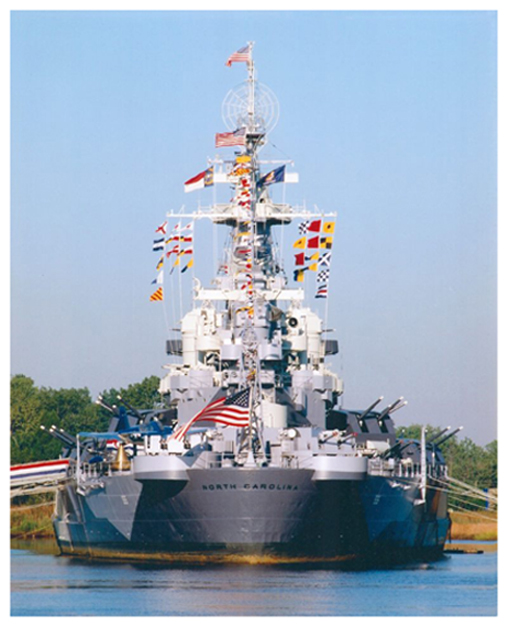menu


The Inside Story
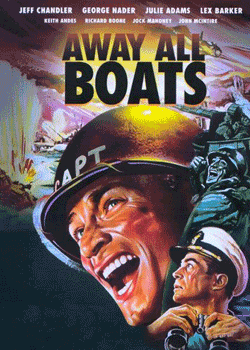
Every story has a beginning, but not every beginning is recognized at the time for what it is. Its significance may be obscured, waiting for that special moment of revelation to occur. But when it finally comes, we become one with the story and the story lives through us. And so it is with the story of the USS Elmore and this website.
My dad served on the USS Elmore (APA-42) during World War II. Like many members of "the greatest generation." he seldom talked about his wartime experiences. Occasionally, a few comments would come out, especially when we watched a WWII movie together. One day, we watched the perfect movie for encouraging his recollections of serving on an attack transport in the Pacific campaign. The movie, Away All Boats, was precisely about his experience during the war.
Away All Boats is a 1956 war movie based on the 1953 novel by Kenneth M. Dodson (1907-1999). Dodson served on the USS Pierce (APA-50) in World War II and used his experiences there as a guide for his novel. He was encouraged in his writing by the noted American poet Carl Sandburg, who had read some of Dodson's letters, written while in the Pacific. The book (and film) is about the crew of the USS Belinda (APA-22), a fictious amphibious attack transport, similar to USS Elmore. The book became a best seller.
Dad loved the movie, even while acknowledging it to be an overblown Hollywood production. But he smiled anyway throughout the movie. He did mention that the Elmore had dodged several kamikazes and also noted that her sister ship, USS DuPage (APA-41), had been hit by a kamikaze, after she took Elmore's place in line. Dad also mentioned that a kamikaze had just missed the Elmore and struck an accompanying destroyer. The Elmore was in the thick of many enemy actions and the element of luck cannot be dismissed. Neither can the power of prayer. The movie highlighted more than a few grains of truth regarding the war in the Pacific and gave me a very memorable opportunity to sit ringside with my dad and watch it all unfold. To this day, that memory remains precious.
My dad served on the USS Elmore (APA-42) during World War II. Like many members of "the greatest generation." he seldom talked about his wartime experiences. Occasionally, a few comments would come out, especially when we watched a WWII movie together. One day, we watched the perfect movie for encouraging his recollections of serving on an attack transport in the Pacific campaign. The movie, Away All Boats, was precisely about his experience during the war.
Away All Boats is a 1956 war movie based on the 1953 novel by Kenneth M. Dodson (1907-1999). Dodson served on the USS Pierce (APA-50) in World War II and used his experiences there as a guide for his novel. He was encouraged in his writing by the noted American poet Carl Sandburg, who had read some of Dodson's letters, written while in the Pacific. The book (and film) is about the crew of the USS Belinda (APA-22), a fictious amphibious attack transport, similar to USS Elmore. The book became a best seller.
Dad loved the movie, even while acknowledging it to be an overblown Hollywood production. But he smiled anyway throughout the movie. He did mention that the Elmore had dodged several kamikazes and also noted that her sister ship, USS DuPage (APA-41), had been hit by a kamikaze, after she took Elmore's place in line. Dad also mentioned that a kamikaze had just missed the Elmore and struck an accompanying destroyer. The Elmore was in the thick of many enemy actions and the element of luck cannot be dismissed. Neither can the power of prayer. The movie highlighted more than a few grains of truth regarding the war in the Pacific and gave me a very memorable opportunity to sit ringside with my dad and watch it all unfold. To this day, that memory remains precious.
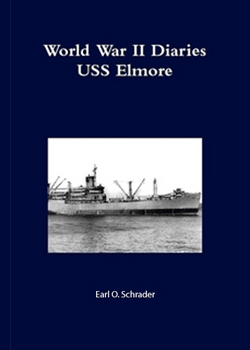
The years passed, as did my father in 1983. One day in 2017, something inexplicable occurred. Late one night, while sitting at my computer, I had an irresistible urge to google my father's ship. Over the years, I had already noted the Elmore's history and specifications in a Wikipedia entry and so I knew a lot about the ship. I even knew the ship's hull number by heart, APA-42. When I performed that search, an entry appeared about a World War II diary by a sailor on the USS Elmore. I was stunned, having never seen this item before. I learned that Earl Schrader, Chief Storekeeper, filled two diaries while serving on the Elmore in 1944 and 1945. The diaries had been stored away for some seventy years in an attic chest. His granddaughter, Robin Lee Hammond, found those diaries and transcribed them for publication. What luck!, I thought. Of course, I ordered the book immediately.
I waited, not altogether patiently, for the book to arrive. Lulu Press is part of the self-publishing industry. Their books are printed on-demand, taking two weeks to arrive after an order has been placed. But the book finally came and it was almost like being a kid again at Christmas getting the best gift ever. I read Chief Schrader's diary and was not disappointed.
Earl gave some amazing accounts of his time on the Elmore with insights and information that only somebody who was actually there could provide. These World War II Diaries, USS Elmore, gave me a priceless insight into what life was like for my dad while serving on that ship.
My curiosity was soon unbound. What started as a gentle rain of curiosity, became a torrent of interest and then a flood of questions. Did Earl know my dad? Why did his entries stop before the end of the war? Why didn't my dad write a similar war diary? Those questions, and many more, needed to find answers. An odyssey of discovery had just begun.
I have always been fascinated by the study of history and the stories of those caught up in the flux of events. Having recently retired, I had the time to engage in historical analysis. A plan formed. Since my dad had chosen not to write a diary, I would do it for him. My two sons had never met their grandfather, having died years before they were born. I would tell his story and introduce my kids to the grandfather that they had never known.
Head first, I dove into the project. I ordered documents from the National Archives: my father's navy records and the Elmore's Deck Log and War Diary. That set me back over $1,500. Cheap at any price, I thought. When I received the records, I was amazed to discover that the ship's log and war diary had not been declassified until December 31, 2012. That was just a few months before I had retired and nearly seventy years after their submittal to the Department of the Navy. I smiled at the thought that the Navy had waited patiently for me to retire before releasing those records for my project.
There were many other resources to explore. I discovered the ship's Muster Roll online at Fold3.com. That gave me the list of the crew, their dates of arrival and departure on the ship and their dates of promotion and, in some cases, demotion. The list of the ship's officers were to be found in the Deck Logs. Having worked in personnel administration for a large governmental entity in Chicago, I felt right at home with those records. This project had been waiting for me all my life. And now I was ready to begin.
I am blessed with a good sense of organization and logic, along with a love of history and biography. The next step was to assemble a library. Within a few months, my collection of books on World War II in the Pacific had grown to well past fifty. As I thought about the project, it slowly occurred to me that this was more than just the story of my father or Chief Schrader. It was the story of the entire crew of the USS Elmore. I wanted to salute those men and their ship and their service to our country. Ultimately, it led to my desire to pay my respect to all members of the US armed forces, both active members and veterans. In the process, I wanted to tell the story of the Elmore and make it interesting and even compelling. And wouldn't it be nice if I could connect with other people that had family members who had served on the Elmore? It all became clear to me. I should start by creating a website about the USS Elmore and her crew. Only then could I write the diary that my dad had not been able to write.
I waited, not altogether patiently, for the book to arrive. Lulu Press is part of the self-publishing industry. Their books are printed on-demand, taking two weeks to arrive after an order has been placed. But the book finally came and it was almost like being a kid again at Christmas getting the best gift ever. I read Chief Schrader's diary and was not disappointed.
Earl gave some amazing accounts of his time on the Elmore with insights and information that only somebody who was actually there could provide. These World War II Diaries, USS Elmore, gave me a priceless insight into what life was like for my dad while serving on that ship.
My curiosity was soon unbound. What started as a gentle rain of curiosity, became a torrent of interest and then a flood of questions. Did Earl know my dad? Why did his entries stop before the end of the war? Why didn't my dad write a similar war diary? Those questions, and many more, needed to find answers. An odyssey of discovery had just begun.
I have always been fascinated by the study of history and the stories of those caught up in the flux of events. Having recently retired, I had the time to engage in historical analysis. A plan formed. Since my dad had chosen not to write a diary, I would do it for him. My two sons had never met their grandfather, having died years before they were born. I would tell his story and introduce my kids to the grandfather that they had never known.
Head first, I dove into the project. I ordered documents from the National Archives: my father's navy records and the Elmore's Deck Log and War Diary. That set me back over $1,500. Cheap at any price, I thought. When I received the records, I was amazed to discover that the ship's log and war diary had not been declassified until December 31, 2012. That was just a few months before I had retired and nearly seventy years after their submittal to the Department of the Navy. I smiled at the thought that the Navy had waited patiently for me to retire before releasing those records for my project.
There were many other resources to explore. I discovered the ship's Muster Roll online at Fold3.com. That gave me the list of the crew, their dates of arrival and departure on the ship and their dates of promotion and, in some cases, demotion. The list of the ship's officers were to be found in the Deck Logs. Having worked in personnel administration for a large governmental entity in Chicago, I felt right at home with those records. This project had been waiting for me all my life. And now I was ready to begin.
I am blessed with a good sense of organization and logic, along with a love of history and biography. The next step was to assemble a library. Within a few months, my collection of books on World War II in the Pacific had grown to well past fifty. As I thought about the project, it slowly occurred to me that this was more than just the story of my father or Chief Schrader. It was the story of the entire crew of the USS Elmore. I wanted to salute those men and their ship and their service to our country. Ultimately, it led to my desire to pay my respect to all members of the US armed forces, both active members and veterans. In the process, I wanted to tell the story of the Elmore and make it interesting and even compelling. And wouldn't it be nice if I could connect with other people that had family members who had served on the Elmore? It all became clear to me. I should start by creating a website about the USS Elmore and her crew. Only then could I write the diary that my dad had not been able to write.
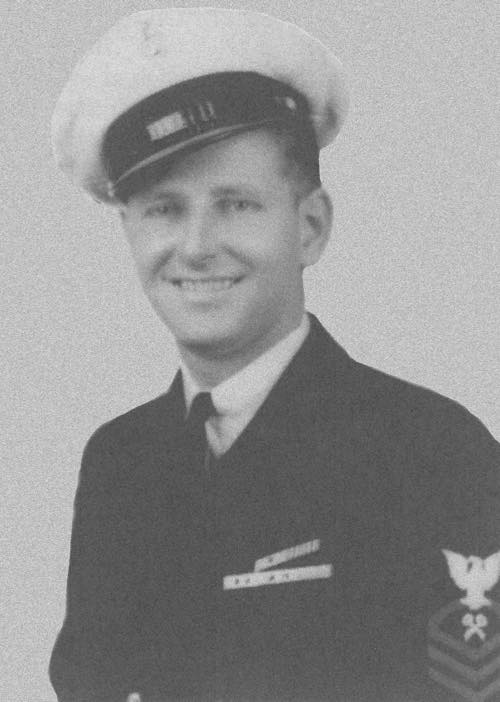
I have read and re-read Earl's diary, Each time I read it, it placed me onboard the Elmore as she sailed into harm's way. As his granddaughter tells the story, Chief Earl O. Schrader served aboard the USS Elmore (APA-42), during WWII in the South Pacific in 1944 and 1945. It was during this time that he wrote two diaries. He held the position of Chief Storekeeper and was based in San Diego, California. His wife Betty and his only daughter, Sandy, were waiting for his return. He was 22 years old.
I would have loved to have met Earl Schrader. Even more than that, I would have loved to have brought the two men together again before my father passed away in 1983. No doubt that Earl and my dad knew each other. The ship had a crew of 51 officers and 524 enlisted men. My dad was a member of the crew on the day that she was commissioned. Earl arrived onboard a few weeks later. Both were enlisted men who eventually were promoted to be chief petty officers. As I studied the blueprints of an attack transport, I was certain that the chiefs had their own bunks and mess hall. I searched the blueprints, deck by deck, and, sure enough, I found it. The chiefs did indeed have their own facilities. There was enough space for 30 chiefs in ten bunks stacked three high. They bunked together. They ate together. They shaved together. Oh, yes, Earl and my dad knew each other and, undoubtedly, they were friends.
I would have loved to have met Earl Schrader. Even more than that, I would have loved to have brought the two men together again before my father passed away in 1983. No doubt that Earl and my dad knew each other. The ship had a crew of 51 officers and 524 enlisted men. My dad was a member of the crew on the day that she was commissioned. Earl arrived onboard a few weeks later. Both were enlisted men who eventually were promoted to be chief petty officers. As I studied the blueprints of an attack transport, I was certain that the chiefs had their own bunks and mess hall. I searched the blueprints, deck by deck, and, sure enough, I found it. The chiefs did indeed have their own facilities. There was enough space for 30 chiefs in ten bunks stacked three high. They bunked together. They ate together. They shaved together. Oh, yes, Earl and my dad knew each other and, undoubtedly, they were friends.
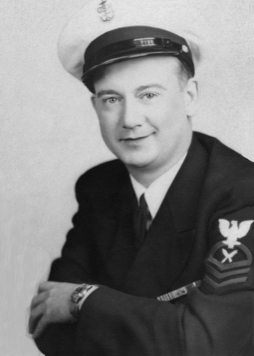
Chief Joseph A. Dudash
I also figured out why my dad had not written a diary. His situation was different from Earl's. Earl was Chief Storekeeper. He dealt with supplies. My dad was Chief Yeoman. He dealt with confidential information and had access to most, if not all, of the ship's classified transmissions. His job demanded absolute discretion. The Navy did not allow for personal diaries on ships because of the danger of such information falling into enemy hands. Given my dad's position, it would not have been a good career move to disobey that directive. While Earl had some leeway, my dad did not. So, I realized, there was a very good reason why dad did not write a diary.
It soon became obvious to me why Earl stopped writing in his diary. After the invasion of Okinawa, the last battle before the scheduled invasion of the Japanese home islands, a number of ships were ordered back to the states for repair and refitting. The Elmore had arrived in the Pacific in January of 1944 and had not been stateside for sixteen months. That changed in May of 1945 when Elmore was ordered to a shipyard in Bremerton, Washington. Each member of the crew got two weeks of leave. Dad took a train back to Pennsylvania to see his family and sweetheart (and future wife, "Birdie"). Earl, who had been in the Navy before the attack on Pearl Harbor, was discharged. He got to go back home to his wife and daughter. His diary entries ended and that was when the two shipmates said their goodbyes. Dad had signed up for Victory plus six months. He would not be discharged until January 1946, a few months after the surrender of Japan.
The USS Elmore was an exceptional ship with an exceptional crew, earning eight battle stars throughout the war. Not that we're keeping score here, but that put her in the top 4% of all APAs. Elmore (and two of her Bayfield-class sister ships) earned the highest number of battle stars of any Bayfield-class or Haskell-class APAs during the war. USS Elmore has a great story to tell or, rather, I have a great story to tell about her. That is what this website is all about. That's the inside story. Now you know.
I also figured out why my dad had not written a diary. His situation was different from Earl's. Earl was Chief Storekeeper. He dealt with supplies. My dad was Chief Yeoman. He dealt with confidential information and had access to most, if not all, of the ship's classified transmissions. His job demanded absolute discretion. The Navy did not allow for personal diaries on ships because of the danger of such information falling into enemy hands. Given my dad's position, it would not have been a good career move to disobey that directive. While Earl had some leeway, my dad did not. So, I realized, there was a very good reason why dad did not write a diary.
It soon became obvious to me why Earl stopped writing in his diary. After the invasion of Okinawa, the last battle before the scheduled invasion of the Japanese home islands, a number of ships were ordered back to the states for repair and refitting. The Elmore had arrived in the Pacific in January of 1944 and had not been stateside for sixteen months. That changed in May of 1945 when Elmore was ordered to a shipyard in Bremerton, Washington. Each member of the crew got two weeks of leave. Dad took a train back to Pennsylvania to see his family and sweetheart (and future wife, "Birdie"). Earl, who had been in the Navy before the attack on Pearl Harbor, was discharged. He got to go back home to his wife and daughter. His diary entries ended and that was when the two shipmates said their goodbyes. Dad had signed up for Victory plus six months. He would not be discharged until January 1946, a few months after the surrender of Japan.
The USS Elmore was an exceptional ship with an exceptional crew, earning eight battle stars throughout the war. Not that we're keeping score here, but that put her in the top 4% of all APAs. Elmore (and two of her Bayfield-class sister ships) earned the highest number of battle stars of any Bayfield-class or Haskell-class APAs during the war. USS Elmore has a great story to tell or, rather, I have a great story to tell about her. That is what this website is all about. That's the inside story. Now you know.




